

A Tiny, Fold-up Electric Car Will Hit Streets This Year. The Hiriko Fold, an electric car that originally began as a research project at MIT, is tiny—smaller than Daimler's smart car.
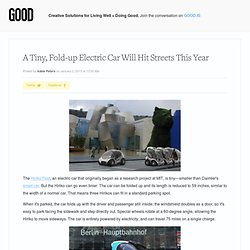
But the Hiriko can go even tinier: The car can be folded up and its length is reduced to 59 inches, similar to the width of a normal car. That means three Hirikos can fit in a standard parking spot. When it's parked, the car folds up with the driver and passenger still inside; the windshield doubles as a door, so it's easy to park facing the sidewalk and step directly out. Special wheels rotate at a 60-degree angle, allowing the Hiriko to move sideways.
The car is entirely powered by electricity, and can travel 75 miles on a single charge. It can't go fast—its top speed is around 31 miles per hour—but it's not intended to. Images courtesy of Hiriko. Bionic Man Unveiled At London's Science Museum. February 7, 2013 Michael Harper for redOrbit.com — Your Universe Online He´s not quite Steve Austin, but with prosthetic hands, hips, knees and even a face, Rex is the closest thing to a bionic man that science has yet to produce.
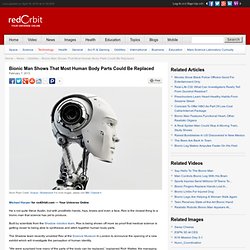
Built by scientists from the Shadow robotics team, Rex is being shown off more as proof that medical science is getting closer to being able to synthesize and stitch together human body parts. The Shadow team recently unveiled Rex at the Science Museum in London to announce the opening of a new exhibit which will investigate the perception of human identity. “We were surprised how many of the parts of the body can be replaced,” explained Rich Walker, the managing director of team Shadow, speaking to The Independent. Peter Suber - Google+ - Major new bill mandating open access introduced in Congress…
Major new bill mandating open access introduced in Congress A new bill mandating OA to federally-funded research was just introduced into both houses of Congress.

It's called the Fair Access to Science and Technology Research, or FASTR. It was introduced in the Senate by John Cornyn (R-TX) and Ron Wyden (D-OR), and in the House by Mike Doyle (D-PA), Zoe Lofgren (D-CA), and Kevin Yoder (R-KS). The quickest introduction is to say that FASTR is a strengthened version of FRPAA. FRPAA was introduced in three earlier sessions of Congress (May 2006, April 2009, and February 2012), with growing momentum each time. Micro-LED LiFi: Where every light source in the world is also TV, and provides gigabit internet access. Researchers at the University of Strathclyde in Scotland has begun the task of bringing high-speed, ubiquitous, LiFi technology to market.

If Martin Dawson and Harald Haas have their way, any illuminated device — your TV, your bedside lamp, a road sign, a train or airport timetable — might soon double up as a wireless LiFi hotspot. LiFi, as you may have guessed, stands for Light-Fidelity — as in, Wireless-Fidelity (WiFi), but using visible light instead of gigahertz radio waves. How LiFi works is very simple: You have an a light on one end (an LED in this case), and a photodetector (light sensor) on the other. If the LED is on, the photodetector registers a binary one; otherwise it’s a binary zero. Flash the LED enough times and you build up a message. Researchers successfully grow defect-free graphene, commercial uses now in sight. The imagined industrial applications for graphene are currently constrained by two things — cost and quality.

There is no concrete roadmap to predict how quickly graphene-based devices will become available and how common they will be. The quality of a sample of graphene depends not only on purity but also on the nature of defects in the geometry. A new method to control the orientation, edge geometry, and thickness of vapor-deposited graphene has just been discovered by a pan-European group of researchers. With continued advances and some newly announced funding initiatives graphene’s full potential as a commercial material is now beginning to come into focus. The legendary strength of graphene is a strict function of the quality of the sample. Getting this kind of performance out of graphene is a little easier said than done. Magnetic logic makes for mutable chips. Software can transform a computer from a word processor to a number cruncher to a video telephone.

But the underlying hardware is unchanged. Cheap, polymer-coated cotton automagically captures water from desert air. Just like how people end up living in the bitter, frostbitten cold, other people end up living in hot, arid regions.

In the cold you need heat — something easily remedied with proper clothing and heating equipment — but in the heat, you need water, which is something you can’t quite create out of man-made components. However, researchers have created a new special coating that, when applied to cotton, can suck water right out of the air. On top of that, once the cotton gets hot enough, it can automatically drain itself. 3D printing with metal: The final frontier of additive manufacturing. The holidays are a great time to sit back, relax, and watch the world happen around you.
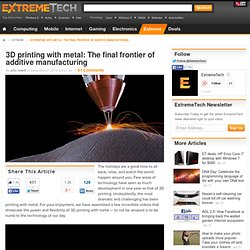
Few areas of technology have seen as much development in one year as that of 3D printing. 20 Game-Changing Technology Trends That Will Create Both Disruption and Opportunity on a Global Level. No matter what industry you’re in, your company can’t survive without technology.
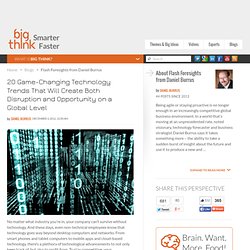
And these days, even non-technical employees know that technology goes way beyond desktop computers and networks. From smart phones and tablet computers to mobile apps and cloud-based technology, there’s a plethora of technological advancements to not only keep track of, but also to profit from. To stay competitive, your organization needs to anticipate the most significant technology trends that are shaping your business and then develop innovative ways to use them to your advantage, both inside and outside of your organization. Remember, if it can be done, it will be done. If you don’t use these technologies to create a competitive advantage, someone else will. Cubify Wants To Domesticate The 3-D Printer. Amongst other surprises at CES this year, young 3-D printing company Cubify took home the Best Emerging Tech award for their second-generation printer, the CubeX.
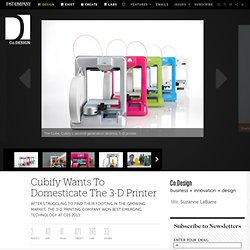
Launched only a year after their first machine, the CubeX and its little brother, the Cube, sell at a significantly lower cost than competitors and are geared toward kids, artists, and other consumers who might not have a ton of experience with the technology. They’re your mother’s 3-D printer--and I mean that in a very good way. The irony behind their friendly, primary-colored marketing materials is that Cubify is actually the consumer brand of the first 3-D printing company ever: 3D Systems, a 30-year-old company founded by inventor Chuck Hull.
Hull patented the first 3-D printer (he called it a stereolithography apparatus) in 1983. He was responsible for everything from developing the .STL file format to engineering the chemical makeup of the material. Express Yourself in 3D.